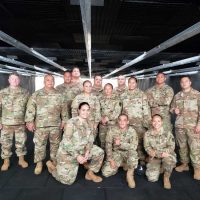
A grand opening for the Army Reserve indoor shooting range is scheduled at the end of April.
This is according to an article in the Defense Visual Information Distribution Service.
It says that Army Reserve Soldiers of American Samoa will soon train at the first indoor rifle range in the Army Reserve, a Modular Small Arms Range scheduled for a grand opening the end of April.
In the article Brigadier Gen. Douglas Anderson, 9th Mission Support Command Commanding General is quoted saying “The sons and daughters of American Samoa serving in the Armed Forces will have the single best indoor training facility in the Army.
“We are providing our Soldiers in American Samoa state of the art training facilities and the ability to conduct training at home, keeping these Citizen Soldiers with their families and employers to the maximum extent possible.”
Prior to this construction, soldiers of the region flew to Hawaii to conduct their regular required training. Now with the training site locally based, Soldiers will be able to complete their annual requirements without having to leave home to do so.
Jon Lee, 9th MSC civilian executive officer, said. “We need to train our Soldiers to be ready so that when they are called to go in harms’ way they can meet the challenge but also defeat the enemy,” “They are all serving our country to protect our freedoms. So we are giving them the newest and best to train and succeed.”
“We have a commitment to the community to build the Soldiers’ readiness so they can be ready at their home station which lessens their time away from their families,” Lee said.
“The first time the 100th Battalion was mobilized to go to Iraq, the Soldiers of American Samoa spent almost 9 months to train and get certified,” he recalled. “So that’s almost two years they were away from home. It shouldn’t be that way.”
The article aalso quotes local soldiers like Staff Sgt Faiupu Tagaleoo. Unit Supply Sergt for Theatre support Group Pacific, Americn Samoa who said, “We now have a greater chance to focus on the mission and training instead of spending a whole day at the shooting range,”. “Now we don’t have to travel 5,000 miles or 10,000 miles to qualify with weapons. We can do it right here at home.”
Sgt. K. Moetala, C. Co. 100th Battalion, 442nd Inf. Regt. says, “I support the building of MSAR because I won’t have to wait a whole year for Annual Training to shoot. “Also I get to train but I will be spending more time with my family.”
Furthermore, Lee stated, the MSAR is safe.
“It has zero escape for a round, 100 percent containment, from the ceiling to the walls to the ground,” he specified. ”We issue ammo inside the building, with the doors closed and lock the building while firing. We take accountability of spent casings. We do accountability before we open the room again.”
The MSAR is also environmentally safe, with a filtration system so the fumes and gases released from the weapons are filtered. An additional benefit of the indoor facility, not only is it environmentally sound, but contains literal sound within from insulation.
“Noise abatement measures have been taken so that our community neighbors aren’t listening to the sounds of the rifle range during a training weekend,” said Anderson.
While maintaining U.S. Army Safety standards during use of the facility, the existence of the facility will also enable law enforcement and other security and protection entities such as the Department of Homeland Security and the Coast Guard, access to train.
Through the duration of construction, 9th MSC has hosted three community town halls continuing the relationship with its neighbors.
“Thanks to the community for participating in the three community engagements that we’ve held,” Anderson said. “Safety is a priority for the Army Reserve and the Modular Small Arms Range is safe and we welcome any opportunity to show this.”
KHJ News points out that the location of the firing range next to Tafuna High School and South Pacific Academy and what appears to be a detour from the usual permitting process for the project has upset parents and residents. They expressed their concerns at two community meetings that were held in February.





